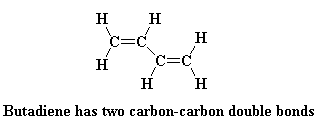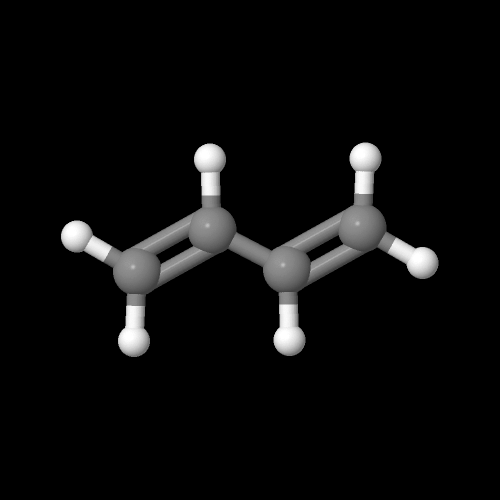

The model on the right above is of the cis polymer you can view by
clicking here or you can just click on the image itself.
Either way, be sure to close the new window that opens up with the
3D model in it when you are ready to come back here.
Polybutadiene was one of the first types of synthetic elastomer, or rubber, to be invented. It didn't take a great a degree of imagination to come up with, as its very similar to natural rubber, polyisoprene. It's good for uses which require exposure to low temperatures. Tires treads are often made of polybutadiene copolymers. Belts, hoses, gaskets and other automobile parts are made from polybutadiene, because it stands up to cold temperatures better than other elastomers. Many polymers can become brittle at low temperatures thanks to a phenomenon called the glass transition. Driving in the winter can be bad enough with out hoses and gaskets going out on you! A hard rubber called poly(styrene-butadiene-styrene), or SBS rubber is a copolymer containing polybutadiene.

Polybutadiene is a diene polymer, that is, it's a polymer made from a monomer that contains two carbon-carbon double bonds, specifically butadiene. It is made by Ziegler-Natta polymerization.

This is what a molecule of the monomer butadiene actually looks like:

The model above is an image of the pdb model you can view
by clicking here or you can just click on the image itself.
Either way, be sure to close the new window that opens up
with the 3D model in it when you are ready to come back here.
Tested Polybutadiene Syntheses
For you lucky people who really, really want to make your own polybutadiene, we actually have not one, but TWO procedures. One gives the mostly cis repeat unit polymer, the other mostly trans. Volatiles and flammable catalysts require extreme care in the lab to be safe: just do it!The two methods use two different transition metal catalysts to give two different isomeric PB's. The first gives the trans isomer: click here to see the procedure and here to download a copy.
The second method using a different catalyst and conditions gives the cis isomer. Needless to say, the two polymers have very different properties. Click here to see the procedure and here to download a copy.
Other polymers used as rubber include:
- Polyisoprene
- Polyisobutylene
- Poly(styrene-butadiene-styrene)
- Polyurethanes
- Polychloroprene
- Silicones

|
Return to Level Two Directory |

|
Return to Macrogalleria Directory |
